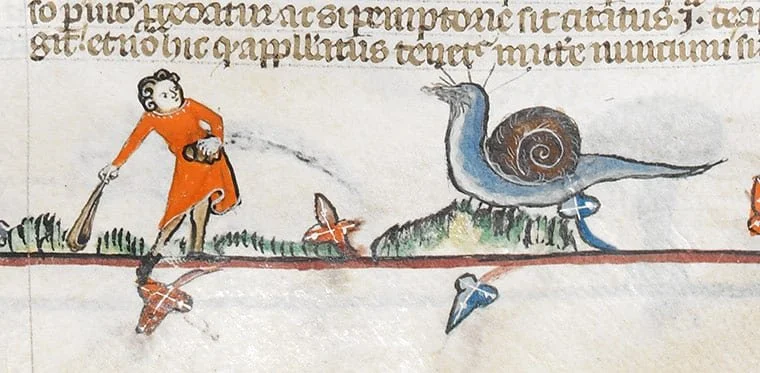Marginalia: Knights vs. Snails
One of the strangest and most delightful mysteries in the margins of medieval manuscripts is the Knight versus Snail motif. Over and over again in psalters, books of hours, and other illuminated texts from the 13th and 14th centuries, we see armored knights brandishing swords, shields, or lances against a humble snail. Sometimes the knight is mounted on horseback, sometimes he’s on foot, sometimes he even looks terrified. Always, the snail holds its ground.
What does it mean? That, to this day, is debated.
Possible Explanations
Mockery of Chivalry: Some scholars argue these images satirized the ideals of knighthood—implying that the mighty knight’s valor amounted to nothing if his great battle was against such a slow, ridiculous opponent.
Symbol of Cowardice: Others suggest the snail, retreating into its shell, symbolized cowardice, making the knight’s struggle a parable of futility.
The Lombards Theory: Another reading holds that the snail represented the Lombards, a northern Italian people despised in parts of Europe for greed and usury. Knights battling snails may have been a coded swipe at social enemies.
Mortality and Resurrection: More poetically, the spiral shell and emerging creature could symbolize the grave and resurrection—casting the knight’s duel as humanity’s struggle with death.
Or… Just Humor: Of course, there’s a strong chance it was simply a running joke among illuminators, a medieval meme that delighted patrons and scribes alike.
Why It Captivates Us Today
Seven centuries later, these whimsical marginal scenes still capture the imagination. They remind us that even within the most solemn manuscripts—sacred texts, prayers, and serious scholarship—scribes and artists left room for humor, absurdity, and satire. The snail and the knight live on as symbols of creative play in the margins.
At Scribe New York, I see these quirky illuminations as an invitation: even in the most polished, serious work, there is always room for wit. The snail reminds us that the margins matter—and that art, like life, is richer when it makes us smile.
This fellow is brandishing a club in an effort to vanquish a snail. (Detail from the Smithfield Decretals, Southern France, c. 1300-1340).
Begging a snail for mercy. (Gorleston Psalter, England, 1310 – 1324)


